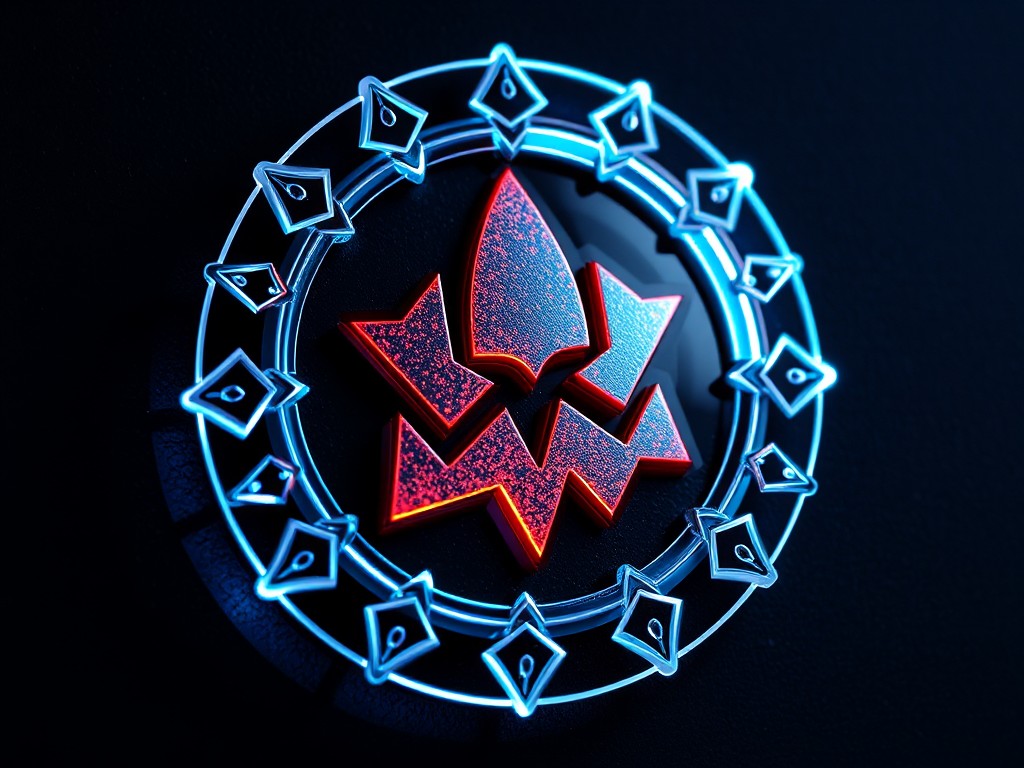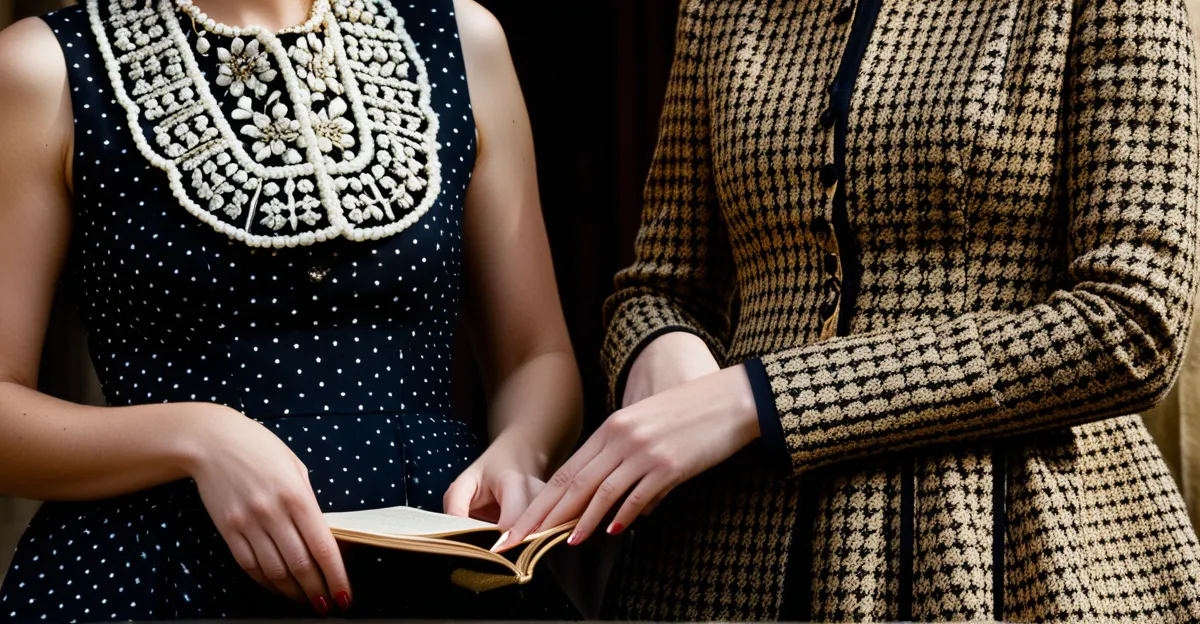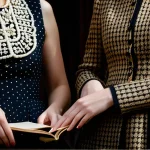Key Historical Periods Shaping UK Women’s Fashion
Throughout UK women’s fashion history, major eras have profoundly influenced the evolution of style, each characterized by distinctive silhouettes and garments reflecting broader societal changes. The Victorian period marked an era of elaborate corsetry, bustles, and voluminous skirts, emphasizing status and modesty. This was followed by the Edwardian era, where fashion began shifting towards lighter fabrics and more practical outerwear, reflecting changing social attitudes.
Moving into the 1920s, the iconic flapper style emerged with its loose silhouettes, beaded dresses, and shorter hemlines, symbolizing a break from tradition and the post-WWI social revolution. The subsequent impact of WWII introduced more utilitarian fashion trends in the UK, driven by fabric rationing that encouraged simpler designs and functional cuts. After the war, the 1950s saw the return of glamour and femininity with fitted waists and fuller skirts, echoing a renewed optimism.
Also to discover : How Can Recent Trends in UK Women’s Fashion Inspire Sustainable Style Choices?
The youth-driven movements of the 1960s to 1980s brought further transformation. The 1960s Mod movement introduced bold colors and miniskirts, popularized by designers like Mary Quant. Later, the rebellious punk style, steeped in DIY aesthetics and defiant attitudes, became synonymous with Vivienne Westwood’s influence, creating a visual narrative of social change.
Each historical fashion period not only encapsulates distinctive UK women’s fashion history but also ties tightly to contemporaneous historical events, illustrating how societal shifts are mirrored in evolving clothing styles and attitudes. This rich legacy continues to inform contemporary British fashion, where past styles are often reinterpreted and woven into current trends.
Additional reading : Can UK Women’s Fashion Trends Boost Self-Esteem?
Victorian and Edwardian Influences
Victorian fashion UK was deeply shaped by strict social norms and the emphasis on status and modesty. Women’s dress was dominated by corsetry, which sculpted the silhouette into the iconic hourglass shape, and bustles that added volume to skirts. These garments were not only style statements but reflected rigid class structures and societal expectations set during Queen Victoria’s reign. The queen’s influence extended beyond the throne; her personal style helped define an era where decorum and propriety heavily dictated women’s fashion choices.
Transitioning into the Edwardian era women’s style, there was a marked shift toward lighter, less restrictive garments. Although still elegant, clothing became more practical and fluid, incorporating softer fabrics and looser fits. This evolution mirrored broader social changes, including growing female participation in public life and movements toward suffrage. Tailored outerwear, such as tailored jackets and simpler skirts, emerged as women sought both style and mobility.
The Edwardian period also introduced the “S-bend” silhouette, which replaced the Victorian corset’s extreme waist cinching with a forward-leaning posture and softer lines. This change in silhouette symbolizes the gradual loosening of strict dress codes. Together, these historical dress influences underpin how UK women’s fashion history reflects shifting social realities, balancing tradition with a growing demand for freedom and modernity. Understanding these layers helps explain why Victorian and Edwardian dress remain foundational references for fashion historians and designers today.
Twentieth-Century Transformations: 1920s to 1950s
The 1920s flapper style represents a pivotal moment in UK women’s fashion history, marking a dramatic shift from previous restrictive silhouettes. Characterized by loose, straight dresses adorned with elaborate beading and dropped waists, flapper dresses symbolized newfound freedom and changing social attitudes following WWI. This era’s fashion revolution UK was driven by young women who embraced shorter hemlines and more relaxed fits, rejecting Victorian and Edwardian constraints.
During WWII, fashion in the UK underwent another significant transformation. Fabric rationing imposed by wartime necessity led to utilitarian trends, favoring functionality and economy over decoration. Clothing became simpler, with less fabric and fewer adornments. Practical elements such as shoulder pads and A-line skirts emerged, allowing women greater mobility as they filled essential wartime roles. This period’s historical fashion periods demonstrate how external events, like war, have direct impact on women’s clothing styles and silhouettes.
Postwar fashion UK embraced a return to glamour and femininity in the 1950s, counterbalancing wartime austerity. Designers introduced fitted waists and full skirts, echoing optimism and renewal. This era rekindled interest in detailed craftsmanship and luxurious fabrics, reestablishing women’s fashion as an expression of elegance and status. The decades between the 1920s and 1950s thus capture a dynamic evolution where societal upheaval repeatedly reshaped both the practicality and symbolism of women’s attire in the UK.
Revolutionary Movements: 1960s to 1980s
The 1960s mod movement stands out as a defining chapter in UK women’s fashion history, marked by its emphasis on youthful energy and modernity. Central to this era was Mary Quant’s iconic miniskirt, which revolutionized the way women expressed independence and freedom through clothing. The miniskirt’s bold hemline and simple silhouette broke from tradition, symbolizing a broader social shift fueled by the postwar generation’s desire for self-expression and change. The mod style’s use of bright colors and geometric patterns helped establish it as an instantly recognizable iconic UK fashion style that still resonates in women’s wardrobes today.
Moving into the 1970s and 1980s, punk fashion UK emerged as a rebellious response to mainstream culture. Punk’s aesthetic was defined by its raw, anti-establishment ethos, characterized by DIY clothing, torn fabrics, safety pins, and provocative slogans. Vivienne Westwood played a pivotal role in shaping this movement, combining street fashion with political commentary. Punk fashion pushed boundaries and challenged societal norms, making it not only a style but also a statement of resistance and individuality within UK women’s fashion history. Its impact extended beyond clothing, influencing music, art, and youth identity across the UK.
This period of historical fashion periods highlights how youth culture fashion UK innovatively merged style with social change. Both the mod and punk movements illustrate fashion’s capacity to reflect and propel cultural shifts. They brought forward concepts of empowerment, rebellion, and personal identity through clothing, altering traditional views and expanding the scope of authenticity and creativity in women’s fashion. These movements also established a lasting legacy, inspiring contemporary British designers who continue to draw upon their boldness and spirit in current UK women’s fashion trends.
Modern Influences and the Legacy of Historical Trends
Historical fashion periods continue to profoundly influence contemporary British fashion, where designers blend heritage with innovation. Many UK women’s fashion trends today draw directly on iconic silhouettes and detailing from Victorian, Edwardian, and postwar eras, creating a dynamic dialogue between past and present. This heritage fashion UK approach honours craftsmanship such as corsetry and tailored outerwear, while interpreting these elements with modern sensibilities and sustainable practices.
Sustainability has become a key consideration in contemporary women’s fashion, encouraging designers to revive and repurpose classic styles thoughtfully. For instance, corsetry—once a symbol of Victorian fashion UK—is reimagined with ethical fabrics and adaptable fits, merging tradition with modern comfort. Similarly, the fluidity of Edwardian era women’s style influences contemporary silhouettes that prioritise both elegance and mobility. This sustainable heritage fashion UK fosters a respect for fashion’s historical lineage while addressing current environmental concerns.
Notable UK fashion events and designers play a vital role in shaping modern trends by continuously referencing these historical trends. Fashion weeks and exhibitions showcase collections that celebrate the evolution of UK women’s fashion history, highlighting how past aesthetics inspire new creations. As a result, contemporary British fashion not only champions innovation but also preserves a rich cultural narrative. This fusion of old and new ensures that iconic UK fashion styles remain vibrant and relevant in today’s global fashion landscape.





